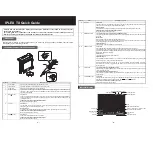
1
RS-925D
1
Introduction
Chapter 1
InTRODUCTIOn
1.1 Introduction
The RS-925 Resistance Standard provides a very
broad-range high-performance resistance source.
The RS-925D Resistance Standard is a precision
resistance source with excellent characteristics of ac-
curacy, stability, temperature coefficient, and power
coefficient. All these features serve to make it a labo
-
ratory resistance standard, exceeded in performance
only by stand-alone standard resistors.
Hermetically sealed wirewound resistors are used
for 1
Ω
steps and over. These resistors are carefully
conditioned under power and temperature in order
to develop the best stability characteristics. Actual
experience has shown them to exhibit a storage sta-
bility of better than 5 ppm/year, improving as they
age. The low-resistance resistors are constructed with
resistance wire with a minimum of copper resistance
in series to limit temperature coefficient effects.
The unit has a fixed minimum resistance of 10 m
Ω
.
This is implemented by mechanically limiting the
10 m
Ω
decade from going below the “1” position. In
this manner, no zero resistance subtractions have to
be made, and the accuracy given is for the absolute
reading.
The RS-925D Resistance Standard employs com-
pletely enclosed dust-tight very low contact resistance
switches. They feature solid silver alloy contacts and
quadruple-leaf silver alloy wipers which keep switch
contact resistance to under 1 m
Ω
per decade, and more
importantly, keep switch contact resistance
reproduc-
ible,
insuring repeatable instrument performance.
High quality gold plated tellurium copper binding
posts minimize the thermal emf effects which would
artificially reflect a change in dc resistance measure
-
ments. All other conductors within the instrument,
as well as the solder employed, contain no metals or
junctions that contribute to thermal emf problems.
TheRS-925D Resistance Standard is designed to al-
low very convenient maintenance of calibration over
time. Most decades are calibratable without changing
components or soldering resistors. The decades for
the 100 Ω through 100 k
Ω
steps are calibrated with
convenient trimmers. Trimming of the lower decades
is also possible.
With a resolution as low as 20 Ω
Ω
and a maximum
available resistance of over 12.1 M
Ω
, the RS-925D-
11-0.001-RH may be employed for exacting precision
measurement applications requiring high accuracy
and stability. It can be used as components of dc and
low frequency ac bridges, for calibration, as transfer
standards, and as RTD simulators.
Figure 1-1: RS-925 Resistance Standard





































